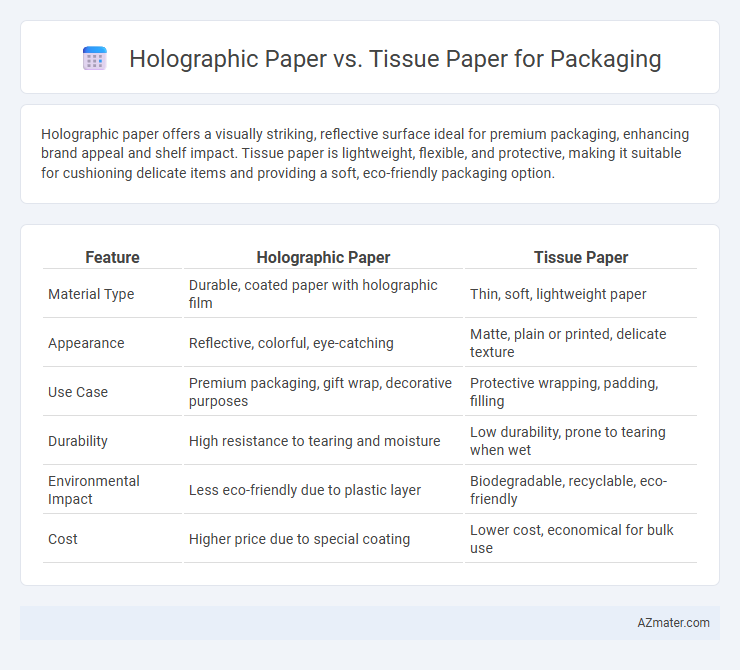Holographic paper offers a visually striking, reflective surface ideal for premium packaging, enhancing brand appeal and shelf impact. Tissue paper is lightweight, flexible, and protective, making it suitable for cushioning delicate items and providing a soft, eco-friendly packaging option.
Table of Comparison
| Feature | Holographic Paper | Tissue Paper |
|---|---|---|
| Material Type | Durable, coated paper with holographic film | Thin, soft, lightweight paper |
| Appearance | Reflective, colorful, eye-catching | Matte, plain or printed, delicate texture |
| Use Case | Premium packaging, gift wrap, decorative purposes | Protective wrapping, padding, filling |
| Durability | High resistance to tearing and moisture | Low durability, prone to tearing when wet |
| Environmental Impact | Less eco-friendly due to plastic layer | Biodegradable, recyclable, eco-friendly |
| Cost | Higher price due to special coating | Lower cost, economical for bulk use |
Introduction to Holographic Paper and Tissue Paper Packaging
Holographic paper packaging features a reflective, multidimensional surface that enhances product visibility and attracts consumer attention through vibrant, eye-catching designs. Tissue paper packaging offers a lightweight, biodegradable solution commonly used for cushioning and wrapping delicate items, providing a soft texture that enhances the unboxing experience. Both materials serve distinct purposes in packaging, with holographic paper prioritizing visual impact and tissue paper emphasizing protection and sustainability.
Material Composition and Manufacturing Processes
Holographic paper consists of a paper base coated with a thin layer of holographic film made from polymers like PET or PVC, produced through embossing or printing techniques that create light-reflective, 3D patterns. Tissue paper is composed primarily of thin cellulose fibers derived from wood pulp or recycled paper, manufactured via a wet pressing process that yields a soft, lightweight, and porous sheet. The distinct material compositions and manufacturing methods of holographic and tissue paper determine their respective uses in packaging, with holographic paper offering decorative visual effects and tissue paper providing delicate cushioning and protection.
Visual Appeal and Aesthetics
Holographic paper enhances packaging with vibrant, multidimensional reflections that capture light and create a dynamic visual impact, making products stand out on shelves. Tissue paper offers a softer, matte finish that conveys elegance and subtlety, often used to protect delicate items while adding a luxurious touch. The choice between holographic and tissue paper depends on the desired brand image, with holographic prioritizing eye-catching aesthetics and tissue paper emphasizing refined, understated presentation.
Durability and Protective Qualities
Holographic paper offers enhanced durability with its resistant surface, making it suitable for packaging that requires visual appeal alongside protection against moisture and minor abrasion. Tissue paper, while softer and more flexible, excels in providing cushioning and preventing scratches on delicate items but lacks resistance to tearing and moisture. For packaging requiring sturdy protection and aesthetic enhancement, holographic paper is preferable, whereas tissue paper is ideal for lightweight, fragile goods needing gentle wrapping.
Environmental Impact and Sustainability
Holographic paper, often coated with metallic films and plastics, poses significant challenges for recycling and biodegradability, increasing environmental impact compared to tissue paper. Tissue paper is biodegradable, compostable, and typically made from recycled or sustainably sourced fibers, making it a more eco-friendly packaging option. Choosing tissue paper supports sustainable packaging initiatives by reducing landfill waste and lowering carbon footprints.
Cost Comparison: Holographic vs Tissue Paper
Holographic paper typically incurs higher production costs due to specialized printing and lamination processes, resulting in a price range of $0.50 to $1.00 per sheet depending on size and quality. Tissue paper, conversely, remains more budget-friendly with costs averaging between $0.05 and $0.20 per sheet, driven by simpler manufacturing and raw material expenses. Businesses weighing packaging options must consider holographic paper's premium price against tissue paper's affordability and sustainability factors.
Customization and Branding Opportunities
Holographic paper offers vibrant, eye-catching designs that enhance brand visibility and create a premium unboxing experience, making it ideal for luxury packaging customization. Tissue paper provides versatile printing options for subtle branding elements and is biodegradable, appealing to eco-conscious consumers seeking sustainable packaging solutions. Both materials enable tailored branding, but holographic paper excels in visual impact while tissue paper emphasizes eco-friendly customization.
Consumer Perception and Unboxing Experience
Holographic paper enhances the unboxing experience by creating a visually striking and premium appearance that elevates consumer perception of the brand's value. Tissue paper offers a softer, more delicate feel that conveys care and protection, appealing to consumers who prioritize sustainability and subtle elegance. Brands balancing holographic paper's vibrant luxury with tissue paper's tactile comfort can optimize packaging to foster emotional connections and memorable consumer experiences.
Suitable Packaging Applications and Use Cases
Holographic paper features a reflective, eye-catching surface ideal for luxury product packaging, gift wraps, and promotional materials where visual appeal enhances brand value. Tissue paper is lightweight, breathable, and soft, making it suitable for delicate item wrapping, cushioning in boxes, and layering in apparel packaging to prevent scratches and maintain product integrity. Both materials serve distinct purposes: holographic paper excels in marketing-driven presentations, while tissue paper prioritizes protection and presentation in delicate packaging scenarios.
Choosing the Right Paper for Your Packaging Needs
Holographic paper offers eye-catching, reflective designs ideal for luxury packaging that demands high visual impact and brand differentiation, while tissue paper provides a lightweight, soft, and cost-effective option perfect for cushioning and protecting delicate items. Selecting the right paper depends on the packaging's purpose: holographic paper enhances aesthetic appeal for premium products, whereas tissue paper excels in functional protection and versatility. Understanding your product's fragility, branding strategy, and budget constraints ensures optimal packaging performance and customer experience.

Infographic: Holographic paper vs Tissue paper for Packaging
 azmater.com
azmater.com